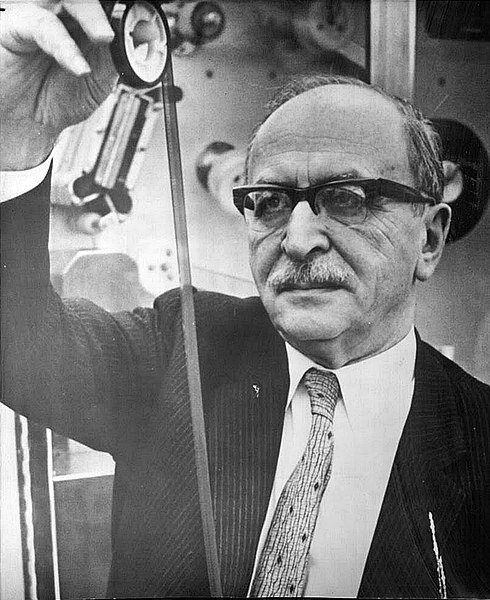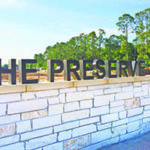The Hungarian Architect of Holography

This is the first in a periodic series of articles that celebrate the lives of the Nobel Prize laureates whose names grace the 100 streets of Laureate Park. These laureates are extraordinary men and women – many of whom are alive today – who, through their lifetime achievements, have made our daily lives immeasurably richer, often in ways not readily evident. Through these articles, we hope to introduce you to these exceptional individuals and encourage you, perhaps, to learn more about them.
“Help me, Obi-Wan Kenobi, you’re my only hope …”
So pleaded a diminutive Princess Leia at the start of the 1977 classic movie Star Wars, the first installment of a series that would eventually grow to nine films. Star Wars would cast a spark to reignite America’s love for the cinema, and the various optical tricks of that first movie enthralled the public, not least among which was the vision of a diaphanous Leia begging for help from the master Jedi, Obi-Wan. This was the first time most Americans had ever seen a hologram, even though George Lucas, the genius behind the Star Wars franchise, had employed holograms in his first feature film, THX 1138, several years earlier.
The concept of holography and its invention actually found its origin in Hungary, amidst the daydreams of an aspiring engineer of Jewish extraction named Dennis Gabor. As a youth, Gabor served in the Austrian-Hungarian army as an artillery specialist in the waning months of the First World War. In the 1920s, Gabor undertook university studies in electrical engineering in his home country but finished his education in Germany, where he landed a job in Berlin at Siemens. But with the rise of the Nazi party in 1933, no Jews were awarded contracts at that company, so Gabor wisely moved on to Great Britain, eventually obtaining British citizenship. In Britain, Gabor was employed at a company whose work focused on the electron microscope. While waiting for a tennis game on Easter Sunday in 1947, pondering the problems of the properties of light, Gabor had a sudden brainstorm for capturing the “entire information” of a solid item using light refraction. The result of his musings, and later experiments, was a process that would reproduce three-dimensional images onto flat surfaces.
The mechanics of holography are not easily described in a few words. But let’s try. Essentially, the concept devised by Gabor uses a ray of light bisected by mirrors into two beams, a reference beam and an object beam. The reference beam travels more or less directly to a photographic plate. The object beam, in contrast, bounces off mirrors to record the form of an object, such as a small eagle toy, then further emits its light into the same photographic plate as the reference beam. The interference pattern generated by the two beams of light creates the three-dimensional image of the hologram.
Gabor dubbed his process “holography” which, roughly translated from the Greek, can be understood as the “whole picture.” One amazing property of holograms is that each individual sliver of the photographic plate contains the entire image of the object recorded, a surprising attribute of holograms that Gabor discovered as he smashed the plate in tiny pieces and examined the image within each piece.
To work properly, however, Gabor’s invention required beams of light that were coherent. Ordinary light, such as that emitted by common household lamps, is incoherent. You might imagine coherent light as packets of photons marching in lockstep, while incoherent photons meander in a chaotic manner. For his initial experiments, Gabor employed a mercury arc lamp with a narrow-band green filter, the best source of coherent light in the 1940s, and his first attempts to produce holograms were admittedly crude. Holography would not benefit from an ideal source of coherent light until the invention of the laser in 1960.
In recent decades, holography has found uses in construction, where engineers can test the load-bearing capacity of materials in 3D virtual models, in medicine in the production of CAT scans, and in the prevention of fraud in driver’s licenses and credit cards. Holograms are truly little wonders.
And so was Gabor a wonder himself. His interests were wide-ranging, and this prodigious inventor we would now classify as a modern Renaissance Man. I do not know if Gabor ever saw Star Wars (he died two years after its release), perhaps chuckling to himself as he watched Leia plead the cause of the galactic Rebellion. But if he did, he might have mused upon his most enduring quote, that “the future cannot be predicted, but futures can be invented.” Dennis Gabor, without a doubt, helped to shape our own present daily lives and inspired us to dream big.

Dennis Delehanty moved to Laureate Park with his wife, Elizabeth, from the Washington, D.C., area in mid-2018. Dennis completed a long career in international affairs at the U.S. Postal Service, the United Nations and the U.S. Department of State, jobs that required extensive global travel and the acquisition of foreign languages. Please contact Dennis about the Laureate Park Nobel Prize honorees or suggestions for future articles at donnagha@gmail.com.


